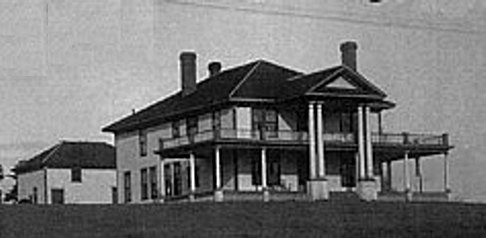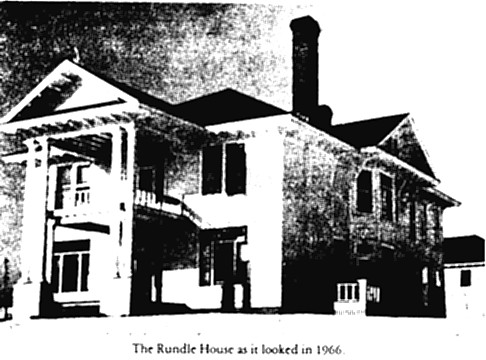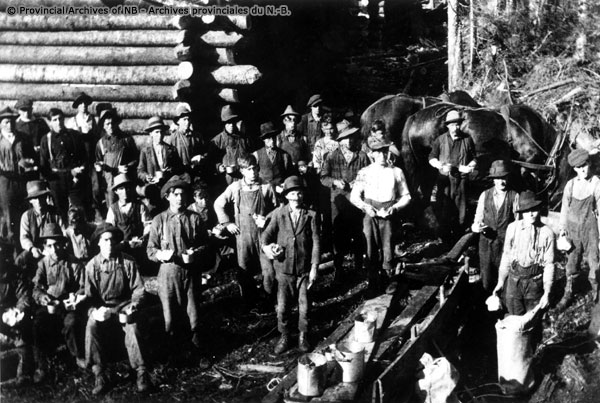

High above Newcastle stands the Rundle house, a landmark since 1911. Generations of Newcastle youth have looked upon it as a mansion, constructed by a lumber lord.
"I have never thought of it as a mansion, just as a family home which we all loved," says Lillian Rundle Cusick, the youngest of the seven Rundle children, who has lived back "home" in one of the apartments since 1972, when she left her home in New York.
The house was built for her father James Rundle by Walter Morell of Newcastle. "Most of the lumber came from Rundles Mill on Bartibogue Island," she explains. "And as you can see, the craftsmanship is exquisite."
Indeed, the dark panelling throughout the front part of the house, the intricately carved stairway with its majestic light standard, the incomparable stained glass and the beautiful fireplaces all attest to pride of construction and ownership.
The story began when James Rundle, whose forebears had come to Canada from England, went as a young man to work for Jim Robinson, a lumberman and member of parliament, in Millerton. There he met Bessie MacMillan whom he married.
He returned to Newcastle and opened a store on Rundle property on the waterfront. After selling out to Baird and Peters he built a mill on Bartibogue Island. "This was in 1907-1908," Mrs. Cusick said. ''The house was built three years later and I remember we moved in just after Christmas in 1912. Things were going well at the mill. My father had good markets in England and New York. In fact, some of our lumber was used to build the subways in New York.
"In 1917 financial problems arose, due in part to declining market conditions. We lost the mill and the house. We moved to Halifax where my father was a lumber broker and we rented a house near the Public Gardens."
Mrs. Cusick remembers very vividly the Halifax explosion on December 6, 1917. "I was going to Halifax Ladies College. When I managed to get home from school I found my mother all cut from flying glass. "
In the meantime, the Rundle house in Newcastle was put up for sale and was acquired by John Rundle, bachelor brother of James who was head of the Miramichi Lumber Company in Chatham. "When he died he left the house to Aunt Emma, a sister married to Herbert MacMillan who ran a shoe store. The house then came into the hands of my brother Clyde and my sister Alice, and was once again the family home."
The house was converted into apartments by the 1940's. Mrs. Cusick, a 1927 graduate nurse from the Royal Victoria Hospital, Montreal and the last surviving member of the Rundle family, now looks after the apartment house and even tends the coal furnace.

As we sat in her father's den off the kitchen, Mrs. Cusick reminisced about her early life. "My father always called me Babe," she said. "We had good times as children. Once a year we would be taken on an outing to Bartibogue Island. I can remember going across the Innes property and over to the island by boat. In the summer we went to Bay du Vin. My father owned the first summer cottage there which he bought from a professor in Fredericton and later sold to Dr. J. D. MacMillan."
As I drove out through the old stone gate-posts, past the carriage-house which also recalled past glories, my thoughts turned to the mill which had flourished on Bartibogue Island for ten years in the early part of this century.

Miss Frances Gordon of Lower Newcastle remembers that scows were used to take the lumber from the mill out to waiting steamers. "The lumber was brought on rafts down the Bartibogue River and towed up to Rundle's mill. I remember in later years there was an extension bridge between the island and the mainland."
She recalled that she and her sister Lou once went over to the mill to collect for a church picnic. Both ladies remember James Rundle and the fact that he used to drive a small red horse.
"We knew several of the men who worked at the mill. Quite often they waited for the river boat at our house."
In those days the Alexandra was running up and down the river and when there was a passenger at the Gordon Wharf, the flag or lantern would be put up and the boat would come in.
Fred Morell of Newcastle, who died in 1978, used to tell of working in the construction of Rundle's mill with his father, of living at the bunkhouse on the island, and of crossing the ice three times a week to go skating in Loggieville. He was 19 years old at the time. He used to speak of Father William Morriscy, renowned healer and priest of nearby St. Peter and St. Paul Church. When he died in 1908, Fred Morell crossed the ice once again, this time to bring the sad news to Father Morriscy's parishioners.
James Loggie of Lower Newcastle worked on the site in 1918 after the mill closed, helping to clean the remainder of the lumber off the island. "I was just a young fellow and I worked there most of the summer and fall,'' he said. "Although I didn't work at the mill I remember hearing a lot about it. I believe it employed 35 or 40 men. Most of them lived on the island and ate at the cookhouse. There were a large number of Frenchmen from Tracadie."
He recalls buying a gramophone with his pay. "It was the first music we had in the house," he said.
Jim Innes, manager of Irving Oil in Newcastle, was named after James Alexander Rundle. He lived adjacent to Bartibogue Island and he remembers as a boy in the twenties playing on the little wagons that were left on the tramways which remained at the mill site.
"There was a water house still there at that time and Joe Muzzerall lived in it for several years. I also remember that the ballast wheel which measured about 14 feet in diameter was there for a long time."
Rev. James Smith of Chatham Head recalled that his father Albert Smith worked at the mill as did Andrew Comeau, who presently resides in Chatham Head.
Bartibogue Island has played an important part in the industrial life of the Miramichi. According to Jim Innes, there is also an old Indian burial ground on the north side marked by a pine hedge. An interesting island, indeed!
(Northumberland News, January 13, 1982)